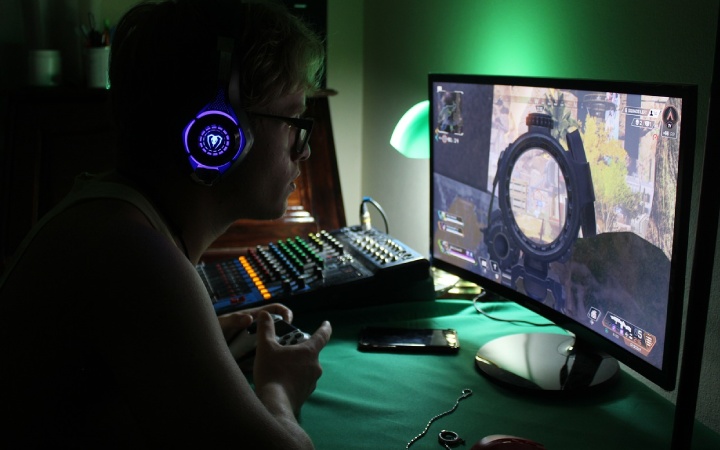CPU vs. GPU: Which Is More Important To Play?

Some gamers think a good GPU or graphics card is the only important thing for a video game to perform well. However, the truth is that they forget another vital part, such as the CPU or microprocessor. Of the three parts that are most important in a configuration, along with RAM, these other processors are vital, as we are going to see. But… which one matters more, CPU vs. GPU? Is it the same for all video games? Let’s see it.
What You Should Know
Before starting to see what is more important, you also have to know what each of these processing units is for since this way; you will understand why each one is important:
What Is The CPU?
A CPU (Central Processing Unit in English) is the essential component of a computer. It is often considered the “brain” of the system since it performs most of the processing and control operations on a computer.
The CPU executes instructions and performs the necessary calculations to carry out a variety of tasks; that is, it is in charge of executing the game, and this includes loading it, handling all of its logic, and sending the graphic instructions to the GPU for that it can process the graphics. Therefore, you must understand that it is more important than you think and could act as a bottleneck.
The Main Functions Of A CPU Are:
Instruction Execution: The CPU interprets and executes the program’s instructions, encoded in machine language. That is, in the case of gaming, the CPU will process the instructions that make up the video game so that it can be executed. These instructions are such as arithmetic and logical operations, such as addition, subtraction, division, multiplication, comparisons, shifts, AND, OR, etc.
Flow Control: the CPU coordinates and controls the sequence of operations and actions that are carried out, and this also implies processing the instructions of the video game’s graphics engine and the graphics API that will be translated as commands to “tell” the GPU what to do. You have to generate the necessary graphs. Therefore, without a good CPU to go along with the GPU, it could cause more lag, with a drop in FPS.
Memory Management: manages and accesses the main memory (RAM), where the data and instructions are stored to run the video game.
I/O management: controls input and output operations, allowing communication between external devices, that is, peripherals such as keyboards, mice, game controllers, etc. Therefore, it is also important in this sense.
What Is The GPU?
A GPU (Graphics Processing Unit) is a hardware component specifically designed to perform calculations and manipulation of graphics and visual processing on a computer or other electronic device. Unlike the CPU, which is designed to handle a variety of general processing tasks, the GPU is highly optimized to perform parallel operations required to render images, videos, and graphics in real-time—that is, for graphics.
GPUs were originally developed to accelerate graphics rendering in applications such as gaming and graphic design. Still, over time, their ability to perform massively parallel computations has been used in various applications beyond graphics.
In fact, before the appearance of GPUs, CPUs were also in charge of processing video game graphics, but that slowed down and greatly limited the graphic capabilities of the time. That is why a dedicated unit was developed.
One of the elementary functions of the GPU is the rendering of video game graphics. That is, transform those commands that arrive from the CPU and the geometric data into graphics or frames that can be sent to the output where the screen is connected so that they can be seen. This involves geometric data processing, texturing, lighting, and shading to create images and visual scenes. You can see how a GPU generates the graphics here for more information. For this, the GPUs have to be efficient when it comes to parallel processing, being able also to handle the capabilities that AI provides in the field of graphics.
CPU vs. GPU: Differences
The main difference between a CPU and vs. GPU in terms of cores lies in their design and how those cores perform different types of tasks. And it is also an interesting topic to learn more about how and when to update them:
CPU
Powerful and Versatile Cores: CPUs generally have fewer cores compared to GPUs, but these cores are more powerful and versatile in terms of executing a wide variety of instructions. They are designed to handle general-purpose tasks and perform complex, sequential operations.
Control and Management Tasks: CPU cores are used primarily for control and logic tasks. They run the operating system, handle input/output operations, manage memory, coordinate the execution of programs, etc.
Complex Multitasking: They are ideal for difficult multitasking, where several complex tasks must be executed simultaneously.
High Individual Performance: Each CPU core can handle a wide range of tasks, making them efficient in processing single and sequential operations.
GPUs
A Large Number of Cores: GPUs contain many smaller cores than CPUs. These kernels are optimized to perform simple computational operations in parallel. That is, it can be said that a GPU has a higher degree of parallelism to execute integer and floating-point instructions. While a CPU can have 2, 4, 8, 16,… complex cores, a GPU can have hundreds or thousands of simple cores. Generally, these kernels are integer units or floating point calculation units rather than integer kernels as such.
Dedication: Although a GPU can also be used as a GPGPU with convenient programming and drivers, the fact is that the GPU is a processing unit specially designed for graphics. Therefore, it is not for execution in general.
And to conclude, say that when choosing a GPU, it is convenient that it has more of these calculation units, such as the CUDA in NVIDIA or the CU in AMD. However, when choosing a
gaming CPU, don’t look for the highest number of cores, as many games are not optimized. Not all video game titles can use more than 2 or 4 cores. Therefore, it will be of little use to choose units such as Intel Core i9, AMD Ryzen 9, Thread ripper, etc. A CPU with higher single-core performance and higher clock frequency is better. This is not the case in a GPU since it would be the opposite; the clock frequency itself is not so important, but the number of graphics processing cores.
CPU vs. GPU: What Is More Important For Gaming?
There is no concrete answer to this question, as you can see. Knowing what more important, CPU vs. GPU is, is not so simple, and you have to analyze each case. For many enthusiasts, the GPU is widely hailed as the essential component in the PC gaming universe. This is because the GPU is in charge of tangibly processing the images, scenarios, and animations displayed. Today’s high-speed games place staggering demands on the rendering power provided by the GPU. Simultaneously, these games are designed to harness the power of multiple cores and threads present in the latest CPUs.
The CPU and the GPU are equally relevant. High-demand games demand both a powerful CPU and a powerful GPU. However, the level of importance they hold for video game titles varies depending on the primary purpose of use and the specific games in question.
During a game, CPUs take on particular tasks that the GPU is not as good at, such as non-playable character (NPC), artificial intelligence (AI) functions, logic, and running the software itself (game ). However, many tasks find better performance in the hands of the GPU.
Certain games perform better when they have multiple cores running, as they take full advantage of their capabilities. In other cases, the difference is not so palpable since they are programmed to use a single core, and consequently, a faster processor would result in better performance. Otherwise, capacity will be insufficient and manifest itself in delays.
Let’s take Minecraft as an example, a game that works with a single core, so it does not require additional resources. In this instance, CPU speed is the only factor that will impact the number of frames per Second (FPS) during the game, without having more cores mattering much. This occurs because the software or program that makes up the video game itself can only be unfolded in one process and not in several processes like multithreaded programs. Of course, the GPU also assumes a crucial role in this title since it will be in charge of processing the graphics.
Types Of Video Games That Need A Better CPU
High-speed games Contemporary games, such as first-person shooters (FPS), multiplayer titles, strategy, sandbox, and open-world experiences, are meticulously designed to capitalize on the benefits provided by the latest generations of CPUs, taking full advantage of their multiple cores and threads. These CPUs are essential to ensure the proper execution of these games. For example, titles like Call of Duty, Cyberpunk 2077, Far Cry, GTA, MMORPG, etc., do benefit well from processors that have four cores or more. You have to know the requirements of these titles well since some impose a minimum number of cores to work well, which can be 4 in some cases. Therefore, the ideal would be to opt for next-generation CPUs such as Intel Core i5 and AMD Ryzen 5 onwards.
In the case of open-world games, it is also vital to have as fast an SSD as possible since a lot of data needs to be loaded from it, and having low latency can make a difference in your FPS rate.
However, for those competitive gamers using high refresh rate (1080p) monitors, the game recommends the AMD Ryzen 7 or Intel i7 for better FPS (games per Second) rates for these high resolutions. In addition, single-core performance and high clock frequency are also still important in these AAA titles, so these parameters should not be forgotten when choosing a processor either.
Also Read: Types Of Virtual Reality Glasses: Characteristics And Differences
Types Of Video Games That Need A Better GPU
Most modern games require high performance from the GPU, sometimes even more than the CPU. 2D and 3D graphics rendering, polygon rendering, texture mapping, and similar tasks demand powerful and fast GPUs. The more efficiently your video card can process information, the more frames per Second you will achieve.
Furthermore, the GPU’s importance becomes increasingly important as the resolution of the game gets higher. While in 1080p or lower titles, the CPU can be more noticeable in the final performance than the GPU itself, in the case of AAA titles with 1440p or 2K resolutions and 4K, the power of the GPU becomes more and more important. In these cases, having a good GPU will make the difference.
Additionally, it is essential to ensure that you have a monitor that meets the recommended specifications (144Hz refresh rate). Otherwise, buying a high-performance graphics card would be meaningless unless you have technologies like NVIDIA’s G-Sync or AMD’s FreeSync. In this case, you won’t have to worry too much about lag. However, it is always best to choose a GPU that generates an FPS rate as close to the refresh rate of the monitor. For example, a GPU that reaches 150 FPS with a 144 Hz monitor can be combined quite well…
The GPU isn’t the only important thing; so is the GPU VRAM. The higher the resolution, the greater the need for graphics memory. For example, there are titles like World of Warcraft that may need around 4GB for 1080p resolutions. However, other newer titles might need more than that, up to 6 or 8GB.
This also depends to a large extent on the quality and the graphics engine used by the video game. For example, it is not the same to move the graphics of a video game from a few years ago, even if it was AAA in its day, then a current AAA title with greatly improved and realistic graphics. Therefore, the higher the graphics quality, the better the GPU should be and the higher the VRAM. For example, Unreal Engine 5 needs more VRAM to work than other previous versions of this graphics engine…
For example, up to now, we could ensure that:
- 2 GB of VRAM: enough to play well at 720p or HD resolutions
- 2-6 GB of VRAM: enough to play games with 1080p or FullHD
- 4-8 GB of VRAM: enough to play games at 1440p or 2K
- >8 GB of VRAM: enough for 4K
But in current video games where each frame, or frame, that the GPU must process has more details due to the graphic quality of the title, it can be said that for 1440p, a minimum of 8GB is needed. And for higher resolutions, it is better to have 12 or 16 GB for modern graphics engines and new-generation video games. In addition, not only the resolution and graphic quality of the video game must be taken into account, but also the graphic configuration you play, since it is not the same to play with low graphics than with a higher degree of detail…
What Should I Update In My Case?
In an ideal scenario, we could easily choose the best of both worlds: CPU vs GPU. Unfortunately, we understand that budget constraints often lead us to make choices between one option and another, at least for now.
Many of the latest games now see multi-core as standard, which means higher frame rates per Second (FPS) and better overall performance. Therefore, you probably want to lean towards processors with quad or six cores in order to play most of the games available on the market.
Dual-core processors can bottleneck the performance of your current graphics card, negatively impacting the gaming experience unless the GPU is also an older, less powerful generation.
Quad-core CPUs, in addition to being cheaper, offer stronger performance and faster speeds compared to their predecessors. As an increasing number of new games rely on multi-core power instead of focusing solely on CPU speed, having a higher number of cores on your system makes a lot of sense. If you’re an avid, forward-thinking gamer looking to ensure you can play high-caliber games that require more processing power and have the financial resources to cope with the high prices, it might be worth considering the options premium both in terms of CPU and GPU.
On the other hand, when it comes to high resolutions and high levels of detail, the GPU becomes more important than the CPU, and this could now be the bottleneck if it is not adequate.
Conclusion: Considerations To Take Into Account
GPUs can be the most expensive component when building your own gaming PC, and if you’re on a budget, it’s important to choose a good balance between CPU and GPU, but which one to spend more on? Well, as I have been saying, this depends on different factors, such as the type of video game. Therefore, we have:
Improve your CPU: if you like fast-paced video games, such as FPS, role-playing games, such as MMORPGs, real-time strategy, etc. That is, those that do not need high graphic capabilities and that are usually played at lower resolutions.
Upgrade your GPU – For open-world games with more immersive environments, highly detailed visual effects, realistic graphics, and high resolutions, or for virtual reality, then better upgrade your GPU.
For more information, I always recommend reading the minimum and recommended requirements of the titles you will play preferably… These can help you get a CPU/GPU equal to or higher than indicated to be sure that it will work well, and even if an update or more modern title comes along, it will continue to be compatible.
Also Read: Design Systems In Corporate Branding






